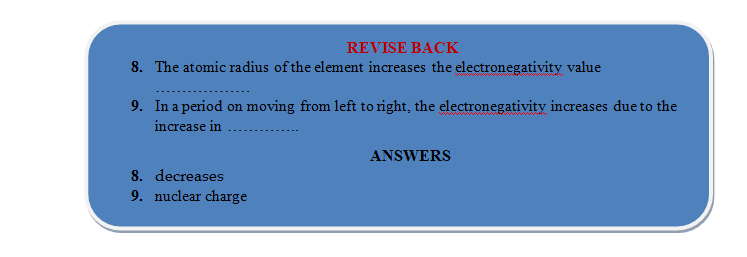ELECTRONEGATIVITY
Chemical Bonding of Class 9
ELECTRONEGATIVITY
- It may be defined as the tendency of an atom to attract the shared pair of electrons towards itself in a covalently bound molecule.
- The numerical value of the electronegativity of an element depends upon its ionisation potential and electron affinity values. Higher ionisation potential and higher electron affinity values implies higher electronegativity value.
Electronegativity scales
Some arbitrary scales for the quantitative measurement of electronegativities are as under
Pauling's scale – Pauling related the resonance energy(Δ)AB of a molecule AB with the electronegativities of the atoms A and B. If xA and xB are the electronegativities of atoms A and B respectivey then
0.208 = xA – xB if xA> xB
= xA – xB if xA> xB
or ΔAB = 23.06 (xA – xB)2
ΔAB = EA-B(experimental) – EA-B(theoretical) where EA-B is the energy of A-B bond. In a purely covalent molecule, AB, the experimental and theoretical values of bond energy A-B are equal.
So ΔAB = 0
Or 0=23.06 (xA – xB)2
Or xA = xB
In an ionic molecule AB, EA-B(experimental) is more than EA-B(Theoretical).
Pauling assumed the electronegativity value of fluorine to be 4 and calculated the electronegativity values of other elements from this value.
ii) Mulliken's electronegativity: According to Mulliken, the electronegativity of an element is the average value of its ionisation potential and electron affinity. Electronegativitiy 
when both are expressed in electron volt
Factors affecting the magnitude of electronegativity
- Atomic radius: As the atomic radius of the element increases the electronegativity value decreases.

Effective nuclear charge: The electronegativity value increases as the effective nuclear charge on the atomic nucleus increases.
Electronegativity α Effective nuclear charge (Zeff)
Oxidation state of the atom: The electronegativity value increases as the oxidation state (i.e. the number of positive charge) of the atom increases.
Periodicity in Electronegativity
- In a period on moving from left to right, the electronegativity increases due to the increase in effective nuclear charge.
- In a period the electronegativity value of IA alkali metal is minimum and that of VIIA halogen is maximum.
- In a group on moving from top to bottom, the electronegativity decreases because atomic radius increases.
- The electronegativity value of F is maximum and that of Cs is minimum in the periodic table.
- The electronegativity of Cs(55) should be more than Fr(87) but it is less. This is due to the increase of +32 units in nuclear charge of Fr which makes the effective nuclear charge comparatively high.
- On moving from second to third transition series in a group [except Y(39) → La|(57)] electronegatvitiy increases due to the increase of +32 units in nuclear charge.
- The electronegativity of inert gas elements of zero group is zero due to stable s2p6 configuration. Inert gases are monoatomic molecules and electronegativity is a property of bonded atoms.
Applications of electronegativity
- Partial ionic character in covalent Bond: The ionic character of a covalent bond increases as the electronegativity difference of bonded atoms increases. According to Haney and Smyth if the electronegativity difference of bonded atoms is Δx then.
Percentage ionic character of the bond = 16Δx+3.5Δx2
If the value of Δx is 2.1 then percentage ionic character is about 50. For example the order of ionic character in H–X bond is as follows–
H–F>H–Cl>H–Br>H–I
because the electronegativity difference of bonded atoms (Δx) decreases.
Bond strength: If the electronegativity difference of covalently bonded atoms (Δx) increases, the bond energy of the covalent bond also increases. For example – the order of the H–X bond strength is –
H–F>H–Cl>H–Br>H–I
As the bond strength is decreasing the acid strength is increasing. So order of increasing acid strength is
HF<HCl<HBr<HI
Acidic and basic nature of oxides of normal elements in a period: The acidic nature of the oxides of normal elements increases as we move from left to right in a period. In a period from left to right the electronegativity of the elements increases. So the difference of the electronegativities of Oxygen and the elements (x0 –xE) decreases. If the (x0 – xE) values is about 2.3 or more then oxide will be basic. If (x0 – xE) values is less than 2.3 the oxide will be acidic. The oxides of the IIIA elements are amphoteric.
The order of acidic or basic nature of the oxides of third period elements may be given as under:
Na2O MgO Al2O3 SiO2 P2O5 SO3 Cl2O7
⎯⎯⎯⎯⎯⎯⎯⎯––––⎯⎯⎯⎯⎯⎯⎯→
The value of x0 – xE is decreasing
Basic nature is decreasing
Acidic nature is increasing
iv) Metallic and non metallic properties of elements
a) The metallic character decreases as the electronegativity of the element
b) On moving from left to right in a period, the electronegativity of the elements increases. So the metallic character decreases.
c) On moving down a group, the electronegativity of the elements decreases. So the metallic character increases.
v) Basic nature of the hydroxides of elements
A hydroxide MOH of an element M may ionise in two ways in water.
M–O–H + H2O  MO– + H3O+ … (1)
MO– + H3O+ … (1)
M–O–H +H2O  MOH2+ + OH– … (2)
MOH2+ + OH– … (2)
If the ionisation is according to eqn (1) then it is acidic. It is possible when ionic character of O–H bonds is more than the ionic character of M-O bond i.e. x0 – xH> x0–xM where x0, xH and xM are the electronegativities of oxygen, hydrogen and element respectively.
If the ionisation is according to eqn. (2) then it is basic. This is only possible when ionic character of O –H bond is less than M–O bond i.e x0 – xH<x0 –xM
Illustration : Electronegativity of Sn in SnCl2 is different from that of Sn in SnCl4 - explain
Solution: The electronegativity values increases as the oxidation state of the atom increases. So the attractive power of Sn(IV) in SnCl4 for electron is much greater that that of Sn(II) in SnCl2.










